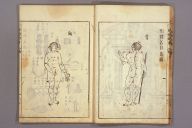Going Dutch
This sword guard depicts a beautiful decoration of a Dutch ship: the hull, the sails, the rear of the ship and the figure head are all depicted in detail. Dutch merchants first arrived in Japan in the early 17th century and were the only Western traders allowed on Japanese territory. They resided on the island of Deshima, near Nagasaki, between 1639 and 1854.
Many images of Dutch ships exist from this time period, and they are most prominent in the “Nagasaki-e”, woodblock prints produced in the area of Nagasaki, which depict the Dutch traders, their ships, as well as their daily lives. Looking both at the tsuba and at an example of Nagasaki-e, we can see that the ship is shown in a very similar manner: in contrast to Western artistic perspectives, we are able to see both the ship’s figurehead from its side, as well as the stern galleries at the rear of the ship from an almost frontal view. The maker of this tsuba may have used one of these prints as a model for the representation of the ship, as the print designers had the possibility to observe the ships up close and depicted them in detail.[Van Gulik 1999]
The abundant portrayal of the Dutch in Japanese art hints at the interest and fascination that the Japanese people had for these foreigners. In fact, while the Dutch were physically limited to the island of Deshima, their influence extended beyond its border: not only were Japanese people buying woodblock prints such as Nagasaki-e, but Japanese scholars, known as rangaku (蘭学), were actively translating and studying Dutch texts about various subjects, such as medicine, science and chemistry.
This tsuba can also be seen as a symbol of this interest, and the collector Peter Dekker hypothesizes that it could have been proudly worn by an Edo period doctor, as a way to symbolize his knowledge of European medicine.[Mandarinmansion]

